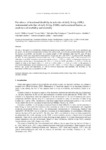Prevalence of functional disability in activities of daily living (ADL), instrumental activities of daily living (IADL) and associated factors, as predictors of morbidity and mortality

Use este enlace para citar
http://hdl.handle.net/2183/14211Coleccións
- Investigación (FCS) [1293]
Metadatos
Mostrar o rexistro completo do ítemTítulo
Prevalence of functional disability in activities of daily living (ADL), instrumental activities of daily living (IADL) and associated factors, as predictors of morbidity and mortalityAutor(es)
Data
2009-06-10Cita bibliográfica
Millán-Calenti JC, Tubío J, Pita-Fernández S, González-Abraldes I, Lorenzo T, Fernández-Arruty T, Maseda A. Prevalence of functional disability in activities of daily living (ADL), instrumental activities of daily living (IADL) and associated factors, as predictors of morbidity and mortality. Arch Gerontol Geriatr. 2010;50:306-310.
Resumo
[Abstract] The aim of this study is to establish the existing relationship among variables referred to the person, specifically age and gender, and the functional dependence in basic ADL and in IADL, as well as the possible relationship it has with the increase of morbidity and mortality in a random sample of 598 individuals older than 65 years. Of these individuals, 34.6% were categorized as dependent for at least one ADL, and 53.5% if we refer to IADL. Regarding the ADL, the risk of dependence increases (odds ratio = OR = 1.089) per year of age, (OR = 2.48) in women’s case; while there is an IADL correlation between age and the score (r = +- 0.527; p < 0.001). A relationship exists between dependence and the days of hospitalization (for ADL: r = +- 0.12, p = 0.018 and IADL: r = +- 0.97, p = 0.003), the number of visits to the doctor (ADL: r = +- 0.27, p < 0.001; IADL: r = +- 0.25, p < 0.001) or the presence of concomitant pathologies such as dementia (ADL: p < 0.001; IADL: p < 0.001). There is a significant association between age, gender and dependence, as well as between dependence and morbidity and mortality, so that dependence could be used as a predictor of both.
Palabras chave
Dependence
Basic activities of daily living (ADL)
Instrumental activities of daily living (IADL)
Elderly people
Morbidity
Mortatlity
Basic activities of daily living (ADL)
Instrumental activities of daily living (IADL)
Elderly people
Morbidity
Mortatlity





